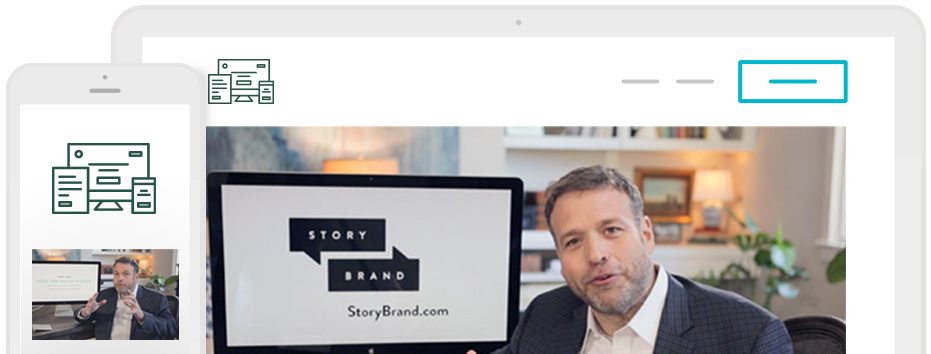
We talk a lot at StoryBrand about clarifying your message so you can stop confusing potential customers and start growing your business.
But growing a business isn’t just about acquiring new customers. It’s about retaining the ones we have. I believe that, for most businesses, the key to doubling your revenue is through your existing customers.
So how can we engage first-time customers so they become loyal, repeat customers?
To answer that question, we need to talk first about how “story” works, especially if you’re new to the StoryBrand world.
The captivating power of story
We’ve been paying attention to stories for centuries. Stories, it turns out, are based on formulas. If you stick to the formulas you can compel a human brain to keep turning the page.
In fact, neuroscientists claim the average human being spends more than 30% of their time daydreaming…unless! Unless they’re reading or watching a movie. Why? Because when we are engaged in a story, the story does the daydreaming for us.
So when we take those captivating story formulas and apply them to our communication, we’ve got a powerful filter that gives instant clarity to what we’re saying — and customers are drawn to listen. People who understand this formula will engage more customers and create more sales.
Story is that powerful, if you understand how it works.
So let’s see how it works for customer retention and engagement.
How story helps you understand your customer’s journey
Every story operates by playing with conflict and resolution.
Consider the first Hunger Games movie. Of course, you’ve got the big conflict: Katniss is in the Hunger Games, fighting for her life. And you’ve got the resolution — spoiler alert! — she outsmarts her opponents and survives.
But along the way, several other smaller conflicts and resolutions propel the story forward. A character gets into a bind, and then finds help to get out of it. For example: Katniss’ sister is chosen for the Hunger Games (conflict), so Katniss volunteers instead (resolution). Once in the Games, Katniss’ friend gets sick, so she works with her mentor to have medicine sent to him in the arena. Another conflict, another resolution — and the story keeps moving forward.
So how can we use this idea of conflict and resolution to engage our customers?
We need to identify our customers’ next pain point (the conflict) and show how we lessen or eliminate it (the resolution).
This is how the customer’s story moves forward, with us as their guide.
When we sell a customer a product, we want to identify their next pain or challenge and help them get out of that conflict. This is how we can use a narrative form to chart their journey.
When we sell a customer a product, we want to identify their next pain or challenge and help them get out of that conflict. This is how we can use a narrative form to chart their journey.
You can do this in a few ways, but I want to give you a simple four-step process that can clarify a path forward if you’re not sure how to start.
Step 1: Scour customer feedback to identify pain points
With each small conflict and resolution in a movie’s plot, we learn something important about the heroes in the story.
So use the same approach in your communication to your customers. As you’re thinking about ways you can serve your customer after the sale, you want to learn about your customer by listening to the kinds of problems they’re still having.
That’s where surveys, social media posts, and forums are gold mines.
Directly ask what your customers are struggling with. Ask the number one challenge they’re facing (as it pertains to your industry). Then, look for the common themes in their responses.
For example, let’s say you own a landscaping company. Landscape design and installation is your bread and butter.
But a year after every installation, you send a survey asking how things are going. You’ve solved your customers’ initial pain point of having overgrown landscaping and dying grass. But now they have a new problem — how to keep it looking great.
A lot of your customers keep telling you that the yard looked nice for a while, but the weeds have crept in over the summer because they don’t have the time for maintenance. Voila — that’s the kind of “conflict,” or pain point, you want to identify.
For more on designing a survey that helps you truly listen to your customer, check out this podcast episode with survey expert David Kinnaman.
Step 2: Offer new products or services based on those pain points
As you pay attention to those common conflicts, you’ll see patterns. Customers tend to follow similar journeys, and if you’re looking closely, you can see the path they’re carving out. For example, after one particular need has been met, this other one almost invariably pops up next. Once you see a fuller picture of your customer’s narrative, you can figure out how to walk alongside them.
Customers tend to follow similar journeys, and if you’re looking closely, you can see the path they’re carving out.
As you identify these major pain points, you can design products and services to help at every step of the way. As Chalene Johnson said in an earlier podcast episode, “It’s easier for them, it’s easier for you, and you’re going to make more money.”
Plus, it’s a more natural sale. You’ve already established trust with your current customers, and trust is critical for selling.
Let’s go back to that landscape company example. You’ve identified this new conflict — homeowners love their landscaping but don’t have time to maintain it. Providing a resolution to this new conflict is a major opportunity for your company to grow.
So you design a monthly subscription-based maintenance plan where your crew provides all the seasonal upkeep for your customers. It helps your customers protect their landscape investment and gives you the all-important recurring revenue in your seasonal business. Plus, they trust that you’ll maintain their yard well because you’ve done a great job installing it.
Step 3: Make your suite of products and services more visible
You may find, as you start listening to your customers, that they’re voicing pain points that you already offer solutions to. Your customers simply didn’t know about it.
If that’s the case, create a product overview one-sheeter.
The big idea behind this piece of marketing collateral is to identify all the ways you serve your customers through existing products and services. Then, simply list them all in one handy checklist that shows all the ways you can help. Do you have this pain? We have this product. Do you have this pain? We offer this service. Do you have this pain? Try this.
Check out this recap of an earlier podcast episode that walks you through it.
Step 4: Use email automation to reach out at key moments in the customer journey
In movies, the timing of the smaller conflicts and resolutions that move the story forward is key. We’ve all been to the movie that drags on and on without action and bores us to tears. Or the one that confuses us with too many problems thrown at us at once.
Great movies time those conflicts and resolutions so the action hits at the perfect moment, both for the character and for us as the viewer.
So timing is a key piece of your strategy as you consider how to reach out at key moments in your customer journey.
How long after their first purchase do customers experience the next common pain point in the journey? That’s when they’ll be most likely to take action.
To figure this out, you can crunch the numbers from existing customers who’ve purchased two products or services. Determine the average time between the initial purchase and the follow-up purchase. Then, experiment with marketing campaigns that reach out around that time. With email marketing automation, you can customize the delivery to each customer based on the exact date he or she purchased.
Let’s go back to our landscape company example. From all the surveys you send after last fall’s installations, you know that people start feeling overwhelmed by the maintenance around May. So you design a three-part email campaign to send in April, offering your maintenance plan so your customers can enjoy the summer without worrying about their landscaping.
—
As entrepreneurs, we often get “shiny object syndrome” and want to cook up new products for new markets. And that’s wonderful. But don’t overlook a key opportunity to grow your business with your existing customers.
By framing up your products and services as mini conflicts and resolutions, you can move your customer’s journey forward and create long-term revenue for your business.
How do you engage your customers after the initial sale? Leave me a comment and share what you’re learning with us.

Want More Free Marketing Advice?
Discover the small-but-mighty tweaks that will make your website dramatically more effective. Sign up for my free video course, 5 Minute Marketing Makeover.





